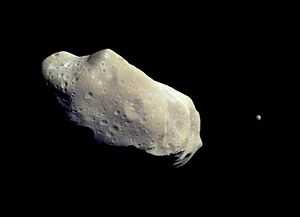Colonization of the asteroids
The asteroids have long been suggested as possible sites for human colonization.[1] This idea is popular in science fiction. Asteroid mining, a proposed industrial process in which asteroids are mined for valuable materials, especially platinum group metals, may be automated or require a crew to remain at the target asteroid.
Advantages
| Space colonization |
|
- Low gravity greatly reduces the cost and risk of "landing" compared to the much deeper gravity wells of the Moon or Mars, and simplifies construction technologies (such as cranes) and reduces structural strength requirements
- Large number of possible sites, with over 300,000 asteroids identified to date
- Asteroids' chemical composition varies (see asteroid spectral types), providing a variety of materials usable in building and fueling spacecraft and space habitats
- Some Earth-crossing asteroids require less energy (delta-v) to reach from Earth than the Moon
- Material mined from asteroids could be a basis for a trade economy, and precious metals may even be returned to Earth or other colonized worlds from asteroid mines for economic gain
- High surface-to-volume ratio enables effective exploration and exploitation of mineral resources and provides maximal portion of useful building ground on the surface and interior
- High vacuum and low gravity would facilitate the evolution of some hi-tech industries such as material engineering and physical electronics (crystal growth, epitaxy)
- Many asteroids (especially the extinct comet cores) contain large amounts (more than 5% of total composition) of water and other volatiles, as well as carbon, which are all necessary for life support. These resources would not only be useful within the asteroid colonies, but could also be "exported" to other locations in the solar system where they were needed, and for a fraction of the energy cost of launching such materials from larger bodies such as the Moon or Mars.
- Isaac Asimov pointed out the advantage of building cities inside hollowed out asteroids, since the volume of all the asteroids put together is a great deal more than that of a mile-high building covering the Earth would be, and thus could accommodate a large population
Disadvantages
- Low gravity. Humans would have to adapt, or some form of artificial gravity would have to be implemented.
- Most asteroids are far from the Sun. The asteroid belt is roughly 2 to 4 times farther from the Sun than Earth. This means that the available solar energy (solar constant) is 4 to 16 times lower than it is at Earth orbit.
- Many asteroids may merely be loose agglomerations of dust and rocks, which may be very difficult to use.
- Asteroids are vulnerable to solar radiation, lacking features functionally comparable to Earth's ozone layer and magnetosphere (though some may have a magnetic field, they are bound to be considerably weaker by comparison).
- Asteroids have no atmosphere.
- Smaller objects may collide with the asteroid and cause significant damage.
Asteroids of special interest

Asteroid 243 Ida is over 53 km long. Its moon, Dactyl on the right
- (6178) 1986 DA is a potentially metallic near-Earth asteroid.
- 216 Kleopatra is a metallic main-belt asteroid.
- Some C-type asteroids are likely carbonaceous chondrites, which are some tens of percent water by mass.
Asteroid colonies in science fiction
Further information: Colonization of asteroids in fiction
See also
- Space colonization
- Manned mission to an asteroid
- Solar System
References
- ↑ Kecskes, Csaba (2002). "Scenarios which may lead to the rise of an asteroid-based technical civilisation". Acta Astronautica (Elsevier) 50 (9): 569–577. doi:10.1016/S0094-5765(01)00208-9. Retrieved May 5, 2012.
- David Gump, Space Enterprise: Beyond NASA, Praeger Publishers, 1990, ISBN 0-275-93314-8.
- Mining the Sky: Untold Riches from the Asteroids, Comets, and Planets
- The Technical and Economic Feasibility of Mining the Near-Earth Asteroids, M. J. Sonter.
- Mining Asteroids at the Wayback Machine (archived February 5, 2005), IEEE Spectrum, August 2001.
| ||||||||||||||||||||||||||||||||||||||